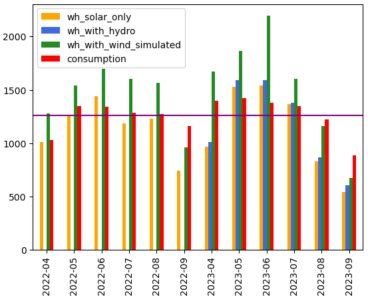onesea
Well-known member
I know there is no black and white answer but….
Having written this I guess the question really how much Solar do you need to run a fridge?
Given 2 vertically mounted 100watt solar panels (they are in effect back to back as side screens) connected to a battery how much power do you get from the sun during the summer period? So unless the sun is behind I count as one 100watt panel.
I know the numbers are variables orientation, weather etc. Just looking at this as a simple roughly how much.
Be aware lots of bad maths and approximations following:
Would you expect it to handle constant averaged 3 amp power draw? that’s about 36 watts or 72 amps.
More bad maths:
Solar generation in raw numbers 100watts at 12v is 8 amps. So say 6 hours good sunshine that should give about 100 watts or 96 amps a day?
Our present set up:
With current draw of about 2 amps (or 48 watts) will handle by the time we have motored for an hour or so a day after 3/4 days the battery voltage is still 12.8v give or take by the time we have motored 30minutes to our berth.
We have never needed to bother orientating the solar panels to gain more energy we like this. We can tilt them if required but if there’s been no need why bother?
The fridge conundrum:
The addition that has added to our power consumption is the fridge. Estimated to draw about 1amp well actually 3 amps when the compressor is running estimated to be 1/3 of time? So that’s 12 amps or 12watts?
At the moment this is considered a luxury and something to keep the milk and beer cold as we are not used to having it. We also have not had chance to really monitor/ optimise get a feel for its power consumption.
Has anyone any practical experience they can draw on?
Having written this I guess the question really how much Solar do you need to run a fridge?
Given 2 vertically mounted 100watt solar panels (they are in effect back to back as side screens) connected to a battery how much power do you get from the sun during the summer period? So unless the sun is behind I count as one 100watt panel.
I know the numbers are variables orientation, weather etc. Just looking at this as a simple roughly how much.
Be aware lots of bad maths and approximations following:
Would you expect it to handle constant averaged 3 amp power draw? that’s about 36 watts or 72 amps.
More bad maths:
Solar generation in raw numbers 100watts at 12v is 8 amps. So say 6 hours good sunshine that should give about 100 watts or 96 amps a day?
Our present set up:
With current draw of about 2 amps (or 48 watts) will handle by the time we have motored for an hour or so a day after 3/4 days the battery voltage is still 12.8v give or take by the time we have motored 30minutes to our berth.
We have never needed to bother orientating the solar panels to gain more energy we like this. We can tilt them if required but if there’s been no need why bother?
The fridge conundrum:
The addition that has added to our power consumption is the fridge. Estimated to draw about 1amp well actually 3 amps when the compressor is running estimated to be 1/3 of time? So that’s 12 amps or 12watts?
At the moment this is considered a luxury and something to keep the milk and beer cold as we are not used to having it. We also have not had chance to really monitor/ optimise get a feel for its power consumption.
Has anyone any practical experience they can draw on?

